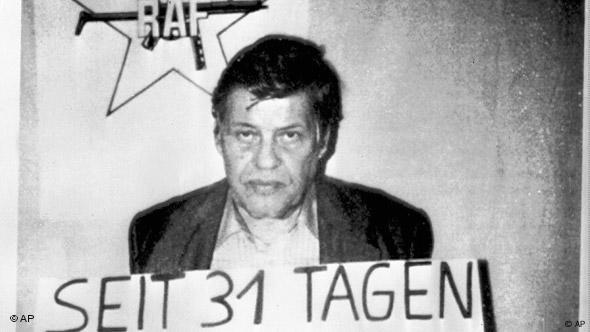DW
03/10/2024
Left-wing terrorism once shook the Federal Republic of Germany. The Red Army Faction emerged from the radicalized student protest movement in the 1960s and '70s.
Left-wing terrorism once shook the Federal Republic of Germany. The Red Army Faction emerged from the radicalized student protest movement in the 1960s and '70s.
Polizei/dpa/picture-alliance
EACH OF THESE MEMBERS OF THE RAF WERE KILLED BY THE STATE WHILE IN PRISON, CLAIMED TO BE SUICIDES
Even today, talk of the Red Army Faction (RAF) often provokes a heated debate in Germany. The crimes of the RAF, said Federal Interior Minister Nancy Faeser (SPD) at the end of February, are "today still unmatched as examples of the dangers of left-wing extremism and left-wing terrorism in the Federal Republic of Germany."
More than a quarter of a century has passed since the terrorist organization announced its dissolution. Nonetheless, there are those who are still grieving, victims who are still injured, RAF members who are still on the run — and many unanswered questions. At the end of February 2024, after many years without success, special police units began once again publicly tracking down the last prominent suspects involved in RAF terrorism.
For those who lived through it, the "German Autumn" (Deutscher Herbst) was in the fall of 1977. That was when the RAF emerged as a far-left terrorist organization.
In 1968, two arson attacks on Frankfurt department stores, using tactics typical of left-wing urban guerrillas, had already occurred. Andreas Baader was convicted and imprisoned for his involvement. His escape from prison in 1970 marked the birth of the RAF. The most prominent members of the first generation of the RAF were Baader, Ulrike Meinhof, and Gudrun Ensslin. In these early years, the group was known as the "Baader-Meinhof Group" after its two most recognizable founders.

In 1977, RAF members kidnapped and later killed business leader Hanns Martin Schleyer
Image: AP
Notorious personalities and lesser-known victims
The group carried out numerous attacks in Germany up into the 1990s. Thirty-five people were killed. Some of the victims were major figures in West Germany.
In 1977 alone, the year of terror, they murdered Siegfried Buback, the country's chief prosecutor, and shortly afterward, the head of the Dresdner Bank, Jürgen Ponto. Then "second generation" RAF members kidnapped Hanns Martin Schleyer, the head of then-West Germany's national employer association and a former SS officer — the SS (Schutzstaffel) was a major paramilitary organization in Nazi Germany. The kidnapping was intended to force the release of imprisoned RAF leaders. When this attempt failed, RAF leaders Andreas Baader, Gudrun Ensslin and Jan-Carl Raspe committed suicide in prison on October 17. Hanns Martin Schleyer was murdered 44 days after his abduction.
The names of the RAF's prominent victims are well known in Germany, but the lesser-known victims include company car drivers, bodyguards and ordinary police officers. Germany was in a state of near paralysis in the autumn of 1977. Frequent vehicle inspections at highway exits and heavily armed police officers at key locations were commonplace. As in several other European countries, a growing fear of terrorism was sweeping the country.
RAF members of the second and third generation continued carrying out crimes until the end of the 1990s. They repeatedly targeted US troop facilities in Germany. Then, in the spring of 1998, the RAF announced in a lengthy letter that it was disbanding.
The manhunt continues, questions remain unanswered
The search for the perpetrators went on, though. Most of the crimes committed between 1970 and 1998 have still not been solved. This is also due to the fact that those RAF members who were arrested and stood trial have, for the most part, not made any incriminating statements about accomplices or connections within the organization. One thing is clear: the RAF and the trail of blood it left across the Federal Republic of Germany are still not a thing of the past.
One of the unanswered questions is the role played by the domestic secret service, the Office for the Protection of the Constitution, in the student protest movement's descent into terror in the late 1960s and early 1970s.
According to the Hamburg political scientist Wolfgang Kraushaar, the secret service agent Peter Urbach (1941-2011) is a key figure here. In an interview with DW in 2018, Kraushaar explained: "Urbach played an important — though still inconclusive — role in the transformation of that small but hardened nucleus of the protest scene into militant groups and ultimately into networks, out of which terrorism then took shape."
In Kraushaar's eyes, Urbach was an agent provocateur who supplied left-wing extremist protesters with Molotov cocktails and firearms and incited the extra-parliamentary opposition. Speculation about the role of the Office for the Protection of the Constitution looms in the background of each new arrest and search for clues.
This is what is behind Federal Interior Minister Nancy Faeser's statement following the arrest of suspected "third-generation RAF" terrorist Daniela Klette at the end of February. She said that a further criminal investigation into the crimes was now possible. "We also owe it to the relatives of the RAF victims to provide answers."
As head of the Federal Ministry of the Interior, which oversees Germany's security agencies, Faeser is the 15th politician to have had more or less frequent dealings with the RAF. When the 53-year-old SPD politician was born, the Federal Criminal Police Office was already searching for the Baader-Meinhof group. It is quite likely that Faeser will not be the last minister tasked with investigating past and future left-wing terrorism.
This article was originally written in German.

No comments:
Post a Comment